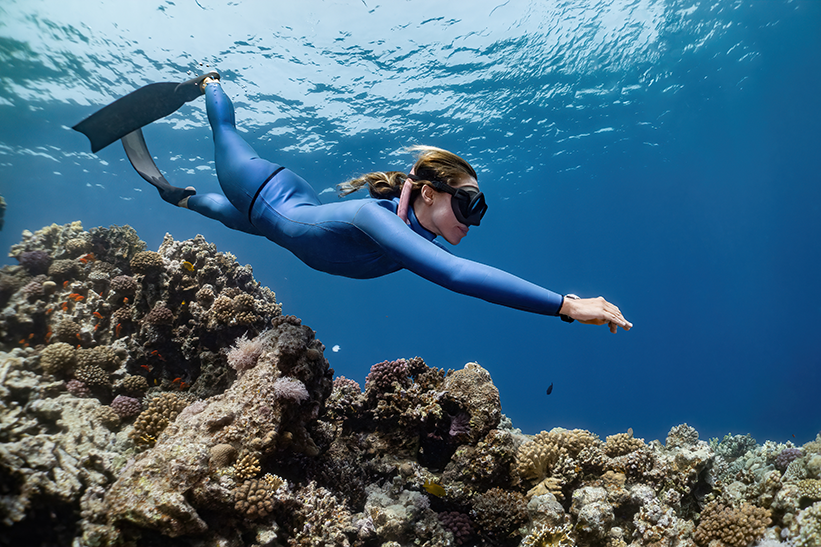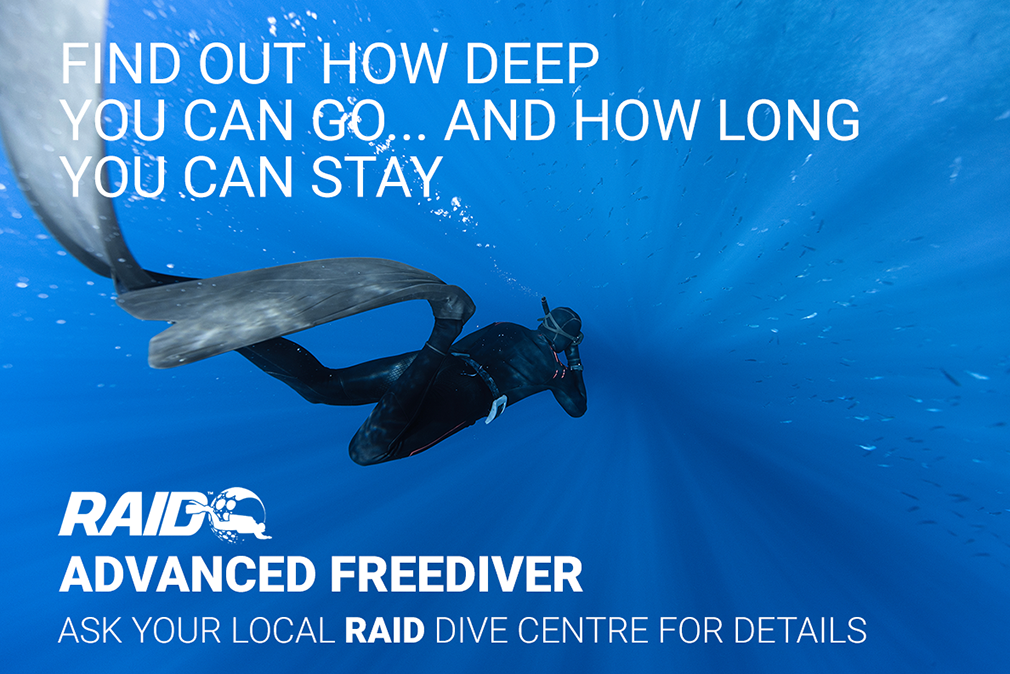ANNOUNCING RAID ADVANCED FREEDIVING COURSE

So, what’s this course all about and why you need it?
This whole course is structured to build on the comfort level you achieved during your RAID Freediver course and refine the core skills of freediving to become a more confident and proficient freediver. Improving your equalization techniques and learning new skills will empower you to overcome barriers and advance safely. The confidence you gain through knowledge and skill development will add to your in-water performance and safety / buddying skills.
Expect to explore experiences of static apnea and free-falling and develop your dive reflex to be quicker and stronger, giving you the edge to safely take your freediving career further. You will also work on dry land techniques to stretch and increase lung capacity through simple but effective exercises.
Most important to know is that your instructor will keep you moving at a pace that is comfortable to you. There is no time limit to complete the skills and if you want more sessions your instructor will advise you. Your progress is very personal and will be a guided journey shared with your experienced RAID advanced freediver instructor.
Some of the open water skills you will perfect
- Frenzel equalization.
- Positioning and streamlining.
- Turning on the rope at depth.
- Free fall negative buoyancy.
- Freedives up to a maximum depth of 30m/100ft.
- Rescue techniques and other safety skills.
- Air conservation techniques.
- You will also demonstrate how to perform shallow water blackout rescue from 15m/50ft.
- Recognize and support divers suffering from DCS, a relatively new concern in advanced freediving.
Format/Duration
The actual number of sessions to complete this course very much depends on the progress of the student and the instructor’s assessment of the student’s comfort performing the required skills. Usually, one day with two in-pool sessions do the trick.
The same criteria apply for the open water sessions. That segment of this course is divided into four distinct sessions. Each session has associated goals and specific targets that students must achieve to earn a pass. And that alone is what will dictate the actual length of your Advanced Freediver Program.
However, the standards for this course do specify minimum limits
To be certified, the student must fulfil the following requirements.
- Minimum of two confined water dive sessions (no session being shorter than 1.5 hours or longer than 3 hours)
- Minimum of four open water dive sessions (minimum 6 hours open water training)
Prerequisites
Each student taking this course must:
- Be a minimum of 15 years old to participate in the Advanced Freediver program
- Obtain guardian permission if a minor
- Have completed the RAID Open Water Freediver course or equivalent and logged a minimum of 6 freediving sessions in total
- Complete the online registration requirements on the RAID training website
- Have a completed medical history from showing no contraindications for freediving activities or have a medical form signed by a licensed medical practitioner
Each student must have a:
- Mask (low volume freediving mask)
- Snorkel (J type, no purge)
- Freediving fins
- Weight belt (rubber or silicone freediving type)
- Adequate exposure suit if required
- Lanyard with quick release system and non-locking carabiner
- Anything else that would be expected or required according to the risk assessment and / or local laws and regulations
- The instructor is required to have a buoy or float with a rope as reference / safety line
CHECK IT OUT RIGHT NOW!
Learn more about the course by visiting RAID’s FREe-Learning. Login to your personal profile or set one up if you don’t already have one… it’s FREE and allows you access to ALL RAID’s courses.
You’ll learn these confined water skills
All Advanced Freediver confined water skills must have been passed and met.
- Perform a static breath hold for 2:30 minutes minimum, demonstrating correct pre-dive breathing technique, avoiding hyperventilation and including correct recovery breathing.
- Perform correct buddying for static discipline including demonstration of correct diver monitoring, communication and coaching.
- Perform a 55m/180ft. dynamic apnea bi-fins dive using flutter kick. Swim at least 55m horizontally underwater, maintaining correct body and head position, bi-finning technique and recovery breaths.
- Perform correct buddying for dynamic apnea. Stay no more than 1.5m/5ft. from the diver for at least the last third of their swim and perform the correct protocols at the surface.
- Perform a dynamic apnea dive demonstrating correct turning (may be combined with the 55m DYN dive).
- Perform a dynamic apnea no fins dive (no minimum distance). Demonstrate correct technique for DNF, using the kick, glide, pull, glide approach.
- Perform a correct blackout and a hypoxic fit rescue scenario (after a static breath hold) on the surface. Rescue a freediver on the surface suffering a simulated blackout and hypoxic fit.
- Perform a correct blackout and a hypoxic fit rescue scenario (for dynamic apnea) underwater, maximum 2m/6ft. Rescue a freediver underwater suffering a simulated blackout and hypoxic fit. Secure the diver’s airways while underwater.
You’ll learn these open water skills
All Advanced Freediver open water skills must have been passed and met.
- Perform a buoyancy check at depth to ensure correct weighting for freediving in open water. Neutral buoyancy should be achieved between 10 and 12 metres / 33 and 40 feet. The freediver should be positively buoyant on the surface in a vertical position, with arms and legs held motionless (arms against the sides, legs straight and together) with a fully exhaled breath, and neutral between 10 and 12 metres.
- Correct use of a freediving buoy and rope. Make correct use of a freediving buoy or surface marker, diver down flag attachment point, resting area and guide rope attachment point as applicable. Demonstrate correct orientation to the line during FIM, CWT and buddying dives.
- Correct freediving buddy system from a minimum depth of 15m/50ft. Demonstrate consistent and correct buddying for a freediver from at least 15m depth, maintaining eye contact no more than 1.5m/5ft. from the diver during ascent, followed by the correct buddy procedures at the surface.
- Perform proper Frenzel equalization technique on descents head-first.
- Perform a free immersion (FIM) freedive to a minimum of 20m/66ft., with correct technique and body positioning, using positive buoyancy on the ascent. Legs should remain relaxed and together throughout the dive.
- Perform a CWT freedive to a minimum of 20m/66ft. using bi-fins. Demonstrate a CWT dive, with correct surface entry protocol (i.e. duck dive), to a minimum depth of 20m/66ft., maintaining proper equalization, finning technique, streamlining and body positioning throughout, and using positive buoyancy on the ascent.
- Perform a correct blackout and a hypoxic fit rescue scenario on the surface. Rescue a freediver on the surface suffering a simulated blackout and hypoxic fit.
- Perform a shallow water blackout (SWB) rescue of a freediver from a minimum depth of 15m/50ft. Complete a CWT dive with proper surface entry and finning technique, to retrieve a simulated unconscious diver at a minimum depth of 15m. Secure the diver’s airways while underwater, and remain oriented to the line during ascent. At the surface remain next to or on the buoy as you support the diver’s airways clear of the water, remove their mask, and implement the blow, tap, talk protocol to revive them.
- Perform a CWT freedive to a minimum of 20m/66ft., and perform a correct turn on the line before ascent. Orienting correctly to the line, grip the line with one hand and allow your body to fall into alignment for your ascent. The turn should be to the side of the line, not into it or away from it, avoiding entanglement.
- Perform a swimming ‘arms only’ ascent from a minimum of 20m/66ft. Complete a CWT dive with proper surface entry and finning technique to a minimum depth of 20m. Using the arms only and a modified breast stroke, complete a swimming ascent to the surface.
- Perform a CWT freedive demonstrating correct free fall technique. Complete a CWT dive with proper surface entry and finning technique to a minimum of 20m. Demonstrate correct free fall, including the slowing down of finning for a gradual transition into freefall.
- Correct use of lanyard. Demonstrate correct use of lanyard, including placement of lanyard in relation to which hand is holding the buoy / line and which hand is used for equalizing. Correct positioning and orientation to the line, and distance from line so that the lanyard travels freely and does not pull on the line.



